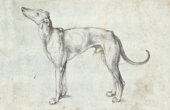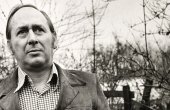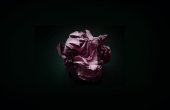A.J. Ashworth: ‘The Guide’
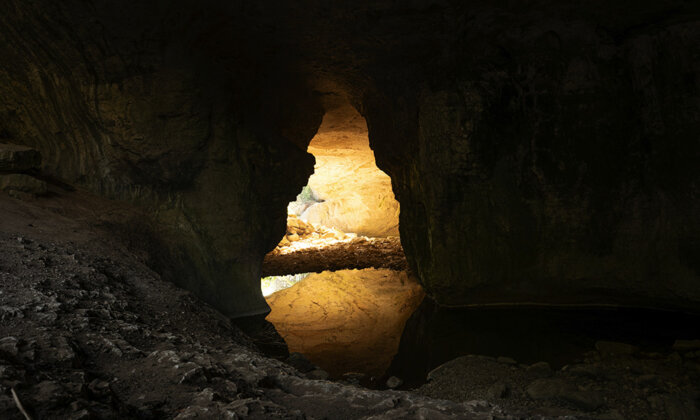
Here he is, entering the cave. See how there is just a flickering of yellow light on the walls, moving with him as he steps further in to the cold blackness. This cave where the sun will never reach; this place which, without his light, would be too dark even for shadows.
He is slow so as not to snuff it out but when the leaf of flame he is holding thins and dims he stops and waits for it to build once more. Watching until the juniper wick fattens with light. Until the horse fat beneath it is slick and glistening with reflections.
You want to know how he’s carrying the light? Well, by stone lamp, carved from red sandstone. See how it is shaped like a spoon with a handle and with a small bowl for the fuel. On the underside of the bowl, where you can’t see, there’s an engraving of an ibex. Its two horns curved as eyebrows. Just a suggestion of eye and nostril. A hint of jaw.
The ibex? It’s an ancient goat.
Old goat? He is? Ah yes, a good joke. A very good joke indeed.
***
See, he is up to the wall now. His free hand touches it, feels its deep cold. There are many meters of rock beneath his palm. Such density keeps out the light and, therefore, the heat. But he has his skins to keep him warm. The skins of bison around his waist and shoulders, stitched together by needles made of sharpened bone. The beginnings of tailored clothing right there before us.
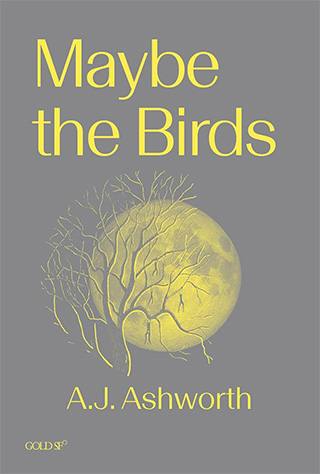
And now, as he crouches, he takes a roll of leather from his waist and unfurls it on the floor of the cave. I know the light is dim but squint a little and you can see our artist’s tools: chunks of rock and charcoal, pouches of fresh bird droppings for his whites, iron oxides for the reds, brushes made with animal hair. The paints were made from minerals, burnt bone meal, charcoal mixed with water or blood, animal fats, tree sap. They were extremely inventive, you’re right. Far more inventive than I’m sure we give them credit for.
But before he starts he will stand and hold his lamp to the paintings and drawings already there – the ones his father made before his sickness and which he will also make now and when his father leaves his body. Making this art is now his work, his role as part of his paleolithic clan. See how close he has to get to the wall, because the light is weak. But there, look, emerging from the rock the heads of four horses in profile and a lone horse with a red back and low, heavy belly. Bears, stags, mammoths, the occasional human in stick form. His father painted them all. As representations of the world beyond the cave, to appeal to the gods for good hunting? Who knows? Their meaning is lost to us now. We can only speculate about their intentions.
What is he going to draw? Patience, patience. Let’s just watch and discover.
A clue? Good heavens. Alright. Perhaps it is something which is half-animal, half-human. I’m saying no more. You will just have to wait and see.
***
Look now.
He is beginning to draw a shape, holding the block of charcoal like a pencil. There is a rump, yes, curved, deer-like, but see how the legs end not in hooves but in feet, human feet. And how the head is the shape of a deer’s but with human eyes, a human nose, human mouth. Unusual indeed, otherworldly. Next he dabs red onto its back to make it more real, to bring it to life. He will even spit the paint onto the rock or smudge it on with his fingers. He will be covered in it once he’s finished, you’re right. More paint on him than flesh. His very own artwork.
Then, beneath it, see, he draws a stick-human, slumped. Perhaps a representation of his father, the sick father I mentioned earlier. Perhaps he sees the creature above the human as one of their gods – a god he hopes will bring his father back to health. Make him the man he was again. But it’s pointless, isn’t it? The two of them have been dead for thousands of years already. Death will come for us all, regardless of our pleading or magic-making, won’t it? But, yet, we try. We still try.
The way the stick-human’s head is hung low makes me think of my own father, it’s true. How he is now, in that place. A spool of saliva falling from his mouth, eyes to the floor, his brain no longer able to thread his thoughts together. He glances at me and gives me someone else’s name. His brother’s. He doesn’t even know who I am so I have to play the part. I can no longer be who I am, his son.
Oh, I’m sorry, I’m sorry. I’m rambling. You don’t want to hear this. You are not here to listen to me talk about myself. You’re here for other things, more interesting things. You’re here for the stories of these wonderful people with their intriguing ways and lives. Not me, not me. I promise I won’t do it again.
***
Next he will do some hand paintings. All the while holding that stone lamp with its fading, flickering light so that he can see at least a small part of the rock, of what he paints. He’s moved now – you can hardly make the creature on the stone out now, the stick-man. They have already been consumed by the blackness.
He takes the paint into his mouth, supping at it as if it’s water, holding his hand to the wall and spitting at it, covering the rock and his hand in paint the color of blood. But look – just the same as when you all used to paint around your hands when you were little – when he takes his hand away… ta-da! The shape of his hand is there surrounded by this rusty brew.
How do I know it was his father he drew earlier?
Well, I don’t of course. It’s just a theory. I know his father is ill and it seems sensible that he’d want to try and do something to make him well again. That’s what any one of us would do.
How do I know his father is ill?
Well, I’m not sure I can answer that. “I just do” doesn’t seem adequate, does it? But he is. I know he is. I can sense it. Anyway, I shouldn’t have allowed myself to meander off into all of that. That’s not why we’re here. We’re here for the art, how it is made. Let’s just concentrate on that. Well, we can try at least.
***
Look now. He takes the black paint into his mouth, places his hand just to the side and spits once more. This time when he removes it the shape is surrounded as if by shadow. The fingers and palm lying within a dark halo; blackness all around.
Is it symbolic of death?
It’s a little threatening maybe, yes. But we are interpreting that from the time and place we are now; we can’t possibly know what this painter intends, if he intends anything at all. Perhaps he just wants to see how his hand will look on the wall. Perhaps he’s just curious.
Yes, you’re right, his hands are large for his size. I’ve never noticed that before. Let me clean my glasses so I can see a little better. Yes, you’re correct. In fact, they’re somewhat reminiscent of my father’s hands. He’s not a big man either. Quite slight; bird-boned. But his hands! They’re the hands of a giant. I used to put my own small hands up to his when I was a child, hoping they would be the same size – but they never were of course. Not even as a man, not even now on those odd occasions where I place my hand to his without his knowing. Mine is always the one within, shadowed by his. He could crush it if he so wished. But he hasn’t become violent, not yet, not yet…
My father could have killed with those hands, but instead he chose to use the brushes and tools of the archaeologist. Digging and uncovering bones, gently dusting sand or dirt from cracked skulls or vertebrae. Yes, perhaps, from the long-buried bones of our painter here – who knows? But I digress once more. We’re not here for my story. I don’t know if I’m reminding you or reminding myself! Let’s get back to our cave artist and see what else we can learn.
***
Now, see, before we leave, the painter returns to the half-human, half-animal creature he painted earlier, and, yes, the stick man. He is going to add to them. Smudge the white bird-droppings onto both bodies so that they’re sharper, more defined. I’m not sure why he didn’t do it before. He’s obviously got an artistic eye – forever tinkering and improving what he’s created.
No, I’ve already said, I’m not sure if this is meant to be a god and the man’s sick father. I was just speculating. There’s no way of knowing. There’s no…
Now, remember, on your way out you can buy postcards of this painting. It will be a nice keepsake for you. Something to remind you of your visit. I have it myself. I placed it on my father’s bedside table and propped it up against the base of the lamp so he can see it from his bed. It’s strange to think of that lamp, that artificial light in my father’s room, illuminating the postcard. While here we have one of the first lamps made by humans, a guttering stone lamp, barely illuminating the real thing. It’s strange indeed. Like a link through time. But I ramble once more.
Any final questions?
No, I don’t think that painted creature, if it was a god, had any powers that could bring his father back. That’s highly unlikely. It didn’t have any powers then and it doesn’t have any now, I’m certain of that. I didn’t buy the postcard for that reason, no. I am not so deluded as to believe that.
***
But now, as the painter leaves the cave with the dying light in his hand, let us also leave, and take with us what we have learned. Try to forget what I told you about the painter’s father, or my father. You will learn nothing from any of that. Just think of the marks on the wall, the animals and the stick figures. How he spat the paints onto the rock, dabbed them with his makeshift brush. Those are the things you need to take from this. Not the other things. Just the man, his work, the cool spit of color against the cave wall.
A. J. Ashworth is the author of the short story collection Somewhere Else, or Even Here, which won Salt Publishing’s Scott Prize, was nominated for the Frank O’Connor International Short Story Award, and shortlisted for the Edge Hill Prize. This story is excerpted from her collection “Maybe the Birds,” published by Goldsmiths Press.
